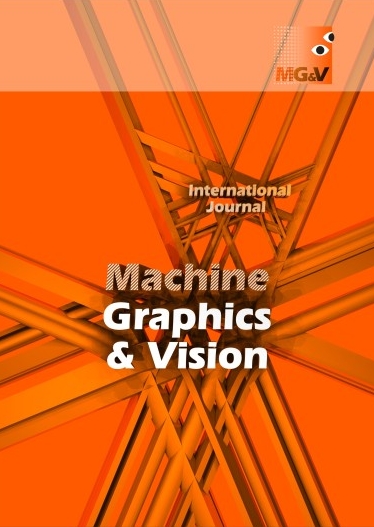Main Article Content
To make virtual reality human-computer games more accurate and provide users with an immersive gaming experience, the study combines the method of improved part intensity field and part association field (PIFPAF) with binocular vision to optimize the interaction of VR human-computer games. The experimental results indicated that the PIFPAF algorithms performed relatively well with number of errors and target keypoint correlation of 0.22 and 0.97, respectively. In terms of processing speed, the algorithm performed faster in both 640×480 and 320×240 resolutions, with 13 fps and 19 fps, respectively. Among the five predefined gestures, the ʻʻpointingʼʼ gesture was recognized correctly the largest number of times in 30 test sessions, with 29 successful identifications. In contrast, the ʻʻclenched fistʼʼ gesture had the fewest correct recognitions, totaling 26. The success of the suggested approach is confirmed by the experimental findings, which show that the optimized human-computer interaction system has high accuracy and processing speed. This study offers a fresh approach to the advancement of human-computer interaction technology and encourages technological integration innovation in the realm of virtual reality human-computer gaming.
Article Details
M. Akram, S. Siddique, and M. G. Alharbi. Clustering algorithm with strength of connectedness for m-polar fuzzy network models. Mathematical Biosciences and Engineering 19(1):420-455, 2022. https://doi.org/10.3934/mbe.2022021. (Crossref)
K. Bonnen, J. S. Matthis, A. Gibaldi, M. S. Banks, D. M. Levi, et al. Binocular vision and the control of foot placement during walking in natural terrain. Scientific reports 11(1):20881, 2021. https://doi.org/10.1038/s41598-021-99846-0. (Crossref)
Z. Cao, G. Hidalgo, T. Simon, S.-E. Wei, and Y. Sheikh. OpenPose: Realtime multi-person 2D pose estimation using part affinity fields. IEEE Transactions on Pattern Analysis and Machine Intelligence 43(1):172-186, 2021. https://doi.org/10.1109/TPAMI.2019.2929257. (Crossref)
B. M. S. Hasan and A. M. Abdulazeez. A review of principal component analysis algorithm for dimensionality reduction. Journal of Soft Computing and Data Mining 2(1):20-30, 2021. https://doi.org/10.30880/jscdm.2021.02.01.003. (Crossref)
K. Head-Marsden, J. Flick, C. J. Ciccarino, and P. Narang. Quantum information and algorithms for correlated quantum matter. Chemical Reviews 121(5):3061-3120, 2021. https://doi.org/10.1021/acs.chemrev.0c00620. (Crossref)
A. R. Inturi, V. M. Manikandan, and V. Garrapally. A novel vision-based fall detection scheme using keypoints of human skeleton with long short-term memory network. Arabian Journal for Science and Engineering 48(2):1143-1155, 2023. https://doi.org/10.1007/s13369-022-06684-x. (Crossref)
J. Katona. A review of human–computer interaction and virtual reality research fields in cognitive infocommunications. Applied Sciences 11(6):2646, 2021. https://doi.org/10.3390/app11062646. (Crossref)
T. Kosch, R. Welsch, L. Chuang, and A. Schmidt. The placebo effect of artificial intelligence in human–computer interaction. ACM Transactions on Computer-Human Interaction 29(6):1-32, 2023. https://doi.org/10.1145/3529225. (Crossref)
S. Kreiss, L. Bertoni, and A. Alahi. PifPaf: Composite fields for human pose estimation. In: 2019 IEEE/CVF Conference on Computer Vision and Pattern Recognition (CVPR), pp. 11969-11978. IEEE Computer Society, 2019. https://doi.org/10.1109/CVPR.2019.01225. (Crossref)
Z. Q. Lan, J. X. Wang, and L. Q. Wang. Multi-view line matching based on multi-view stereo vision and leiden graph clustering. Journal of Geo-Information Science 26(7):1629-1645, 2024. https://doi.org/10.12082/dqxxkx.2024.240080.
K. Li and X. Li. AI driven human–computer interaction design framework of virtual environment based on comprehensive semantic data analysis with feature extraction. International Journal of Speech Technology 25(4):863-877, 2022. https://doi.org/10.1007/s10772-021-09954-5. (Crossref)
Y. Lin, W. Chi, W. Sun, S. Liu, and D. Fan. Human action recognition algorithm based on improved resnet and skeletal keypoints in single image. Mathematical Problems in Engineering 2020(1):6954174, 2020. https://doi.org/10.1155/2020/6954174. (Crossref)
N. S. Logan, H. Radhakrishnan, F. E. Cruickshank, P. M. Allen, P. K. Bandela, et al. Imi accommodation and binocular vision in myopia development and progression. Investigative Ophthalmology & Visual Science 62(5):4, 2021. https://doi.org/10.1167/iovs.62.5.4. (Crossref)
Z. Lyu. State-of-the-art human-computer-interaction in metaverse. International Journal of Human–Computer Interaction 40(21):6690-6708, 2024. https://doi.org/10.1080/10447318.2023.2248833. (Crossref)
J. Ramadoss, J. Venkatesh, S. Joshi, P. K. Shukla, S. S. Jamal, et al. Computer vision for human‐computer interaction using noninvasive technology. Scientific Programming 2021(1):3902030, 2021. https://doi.org/10.1155/2021/3902030. (Crossref)
J. C. A. Read. Binocular vision and stereopsis across the animal kingdom. Annual Review of Vision Science 7(1):389-415, 2021. https://doi.org/10.1146/annurev-vision-093019-113212. (Crossref)
G. R. E. Said. Metaverse-based learning opportunities and challenges: a phenomenological metaverse human–computer interaction study. Electronics 12(6):1379, 2023. https://doi.org/10.3390/electronics12061379. (Crossref)
S. Seinfeld, T. Feuchtner, A. Maselli, and J. Müller. User representations in human-computer interaction. Human–Computer Interaction 36(5-6):400-438, 2021. https://doi.org/10.1080/07370024.2020.1724790. (Crossref)
W. Xu, B. Chen, Y. Hu, and J. Li. A novel wide-band directional music algorithm using the strength proportion. Sensors 23(9):4562, 2023. https://doi.org/10.3390/s23094562. (Crossref)
J. Zhang, Z. Chen, and D. Tao. Towards high performance human keypoint detection. International Journal of Computer Vision 129(9):2639-2662, 2021. https://doi.org/10.1007/s11263-021-01482-8. (Crossref)
Z. Zhang. Flexible camera calibration by viewing a plane from unknown orientations. In: Seventh IEEE International Conference on Computer Vision, vol. 1, pp. 666-673, 1999. https://doi.org/10.1109/ICCV.1999.791289. (Crossref)
Z. Zimiao, X. Kai, W. Yanan, Z. Shihai, and Q. Yang. A simple and precise calibration method for binocular vision. Measurement Science and Technology 33(6):065016, 2022. https://doi.org/10.1088/1361-6501/ac4ce5. (Crossref)





